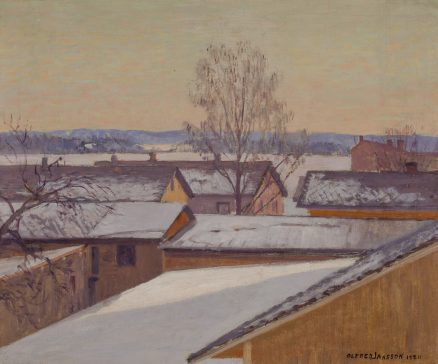- Categories
- Immigrant artists
- Landscapes
- Zoom in on Artwork
- Print Page
- Email Page to Friend
Alfred Jansson’s view of a frozen lake over low rooftops explores the soft light and pastel tints of winter sunlight in frigid atmosphere. Creating a patchwork of orange, lavender, and white, the angular shapes of walls and snowy tiled roofs dominate the bottom two-thirds of the picture; above, an ice-bound expanse of water bordered by low hills is compressed under a subtly mottled sky. Only the erect bare tree at center and a thin screen of branches at the lower left interrupt the rigorous geometry of the composition.
By the late 1910s, Jansson had established his reputation in Chicago as a painter of landscapes, especially winter scenes. The artist’s typical settings were woods and fields treated as vehicles for the subtle poetry of nature’s moods. In contrast, this landscape emphasizes the specifics of a particular if unidentified place, presenting it with straightforward realism as well as a distinctly modern concern for formal design. The view appears as if from a window, casually glimpsed rather than deliberately framed by the artist’s selective vision.
In 1922, when Jansson was in his late fifties, he made a return trip to his native Sweden. According to his passport application, his purpose was to visit relatives as well as to paint. This work may picture the artist’s birthplace of Arvika: consistent with the view shown here, the town sits on the shore of a lake, fringed by low hills, that opens onto Sweden’s only inland fjord. The weak glancing light in Jansson’s painting corresponds with the effect of the midday sun during the brief days of Scandinavian winter.
Wendy Greenhouse, PhD
Donated by M. Christine Schwartz to the Newberry Library, Chicago, Illinois, in 2021

